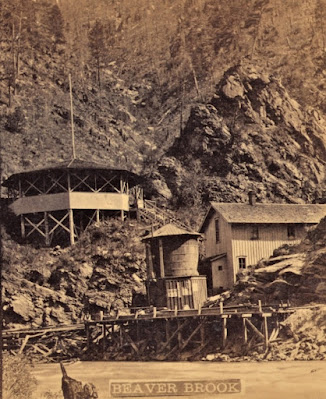A gold rush to the area started in 1859, following gold discoveries in the gravel of Clear Creek. George A. Jackson made a strike early that year near what would become Idaho Springs, where Chicago Creek joins Clear Creek (Ubbelohde, et al., 2015). A few months later, John H. Gregory panned $80 in nuggets out of gravels of the North Fork of Clear Creek not far from Jackson’s discovery (Abbot, et al., 1994). His location became known as Gregory Gulch. Prospectors and miners streamed into the area.
Soon Black Hawk, Central City, and Nevadaville were established (Ubbelohde, et al., 2015). These early discoveries launched the second largest gold excitement in the nation’s history.
Prospectors, miners, and entrepreneurs developed access to the area. Edward Berthoud completed the Clear Creek Wagon Road by 1862. The Colorado Central Railroad followed in the 1870s and was extended through Clear Creek canyon in 1872 (Holden, 2016). The trip through the canyon was a wild ride. The train lurched and swayed as it slowly steamed along tracks above the creek. Its whistle pierced the air. Valve gears hissed, chuffed, and clanked. Wheels clacked on the rail joints in a rhythm that lulled the passengers into daydreams. When the train went around curves, the wheel flanges squealed and snapped riders out of their reverie. Cinders from the smokestack blew through open windows onto passengers who were packed into seats. The smells of coal smoke and lube oil from the locomotive filled the canyon.
The Colorado Central Railroad also brought wide-eyed tourists who enjoyed waterfalls, wildlife, and cliffs as the train rolled through the scenic canyon. Beaver Brook station (shown in figure 2) was midway through the canyon and became a favored tourist stop (Abbott, et al., 2007). At Beaver Brook station, passengers marveled at the steep canyon walls, stretched their legs, enjoyed lunch, and accessed hiking trails (Holden, 2016). The railroad also built a picturesque pavilion perched on the slope above the station. Passengers spent time outside on the platform of the pavilion, where they ate picnics and enjoyed the views and the fresh mountain air.
This narrow-gauge line became part of the Colorado & Southern Railway and continued operations through Clear Creek Canyon until 1941, when the railroad became unprofitable and the rails were removed (Holden, 2016). Today, some say that if you listen carefully, you can still hear the whistle blow as the train winds its way through Clear Creek Canyon.
Acknowledgments: The author thanks Pete Doolittle for improving this article.
References and further reading:
Abbott, C., S. J. Leonard, and D. McComb, 1994, Colorado: A History of the Centennial State: Niwot, University Press of Colorado.
Abbott, D., D.A McCoy, and R. W. McLeod, 2007, Colorado Central Railroad: Denver, Sundance Publishing.
Holden, G. S., 2016, Clear Creek Canyon. Colorado Encyclopedia, retrieved from https://coloradoencyclopedia.org/article/clear-creek-canyon on June 6, 2021.
Ubbelohde, C, M. Benson, and D. Smith, 2015, A History of Colorado: Portland, West Winds Press.



No comments:
New comments are not allowed.